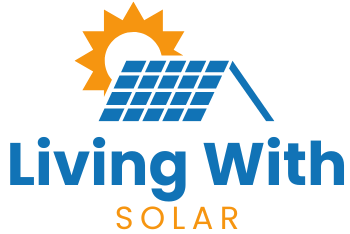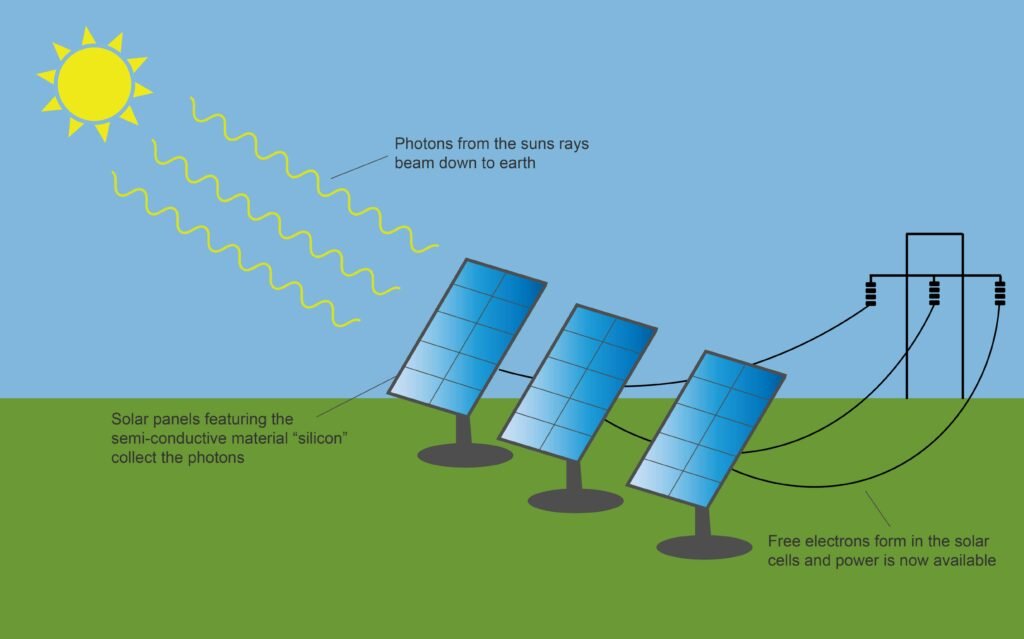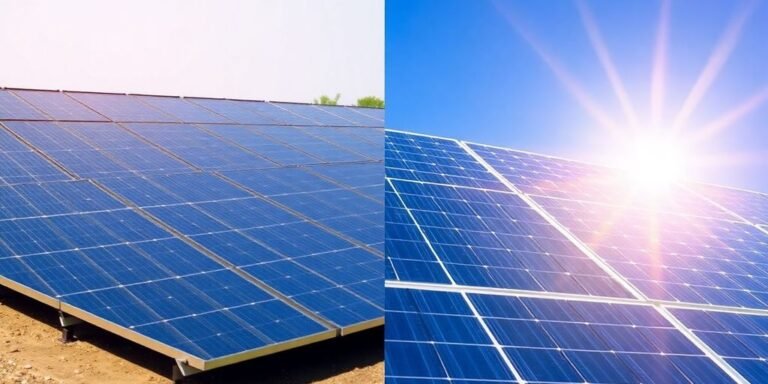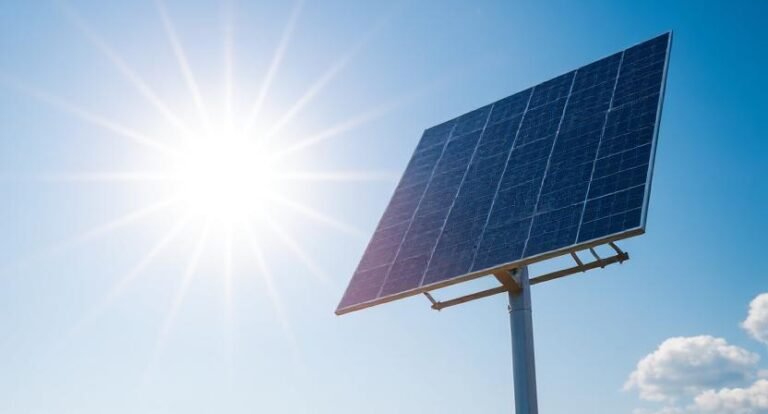Ever wonder how those shiny panels on rooftops turn sunlight into electricity? It’s not magic, but a clever use of science.
Solar panels, often seen glistening under the sun, are more than just a trend—they’re a key player in renewable energy.
They take the sun’s rays and convert them into electricity you can use at home. Let’s break down how these panels work and why they’re becoming so popular.
Key Takeaways
- Solar panels are primarily made of silicon, a semiconductor that captures sunlight and converts it into electricity.
- The photovoltaic effect is the process that allows solar panels to create direct current (DC) electricity from sunlight.
- Inverters are crucial in solar systems as they convert DC electricity into alternating current (AC), which powers homes and businesses.
- There are different types of solar panels, including photovoltaic (PV) and solar thermal panels, each with unique applications.
- Solar panels offer environmental and economic benefits, contributing to reduced carbon footprints and energy costs.
Understanding the Basics of Solar Panels
What Are Solar Panels Made Of?
Solar panels might look like simple sheets of glass, but there’s a lot more going on beneath the surface.
They’re primarily made up of photovoltaic cells, which are usually composed of silicon. These cells are sandwiched between layers of semi-conducting materials that have different electronic properties.
When sunlight hits these cells, it creates an electric field across the layers, sparking the flow of electricity. The panels also include a metal frame and a glass casing to protect the delicate cells from the elements.
How Do Solar Panels Capture Sunlight?
Capturing sunlight isn’t just about facing the sun. Solar panels are designed to maximize the amount of sunlight they absorb.
The photovoltaic cells are grouped into arrays and positioned to capture the most sunlight throughout the day.
The angle and orientation of these panels can significantly affect their efficiency. This is why you often see solar panels on rooftops or in open fields, angled perfectly to greet the sun.
The Role of Photovoltaic Cells in Solar Panels
Photovoltaic cells are the heart of any solar panel. These cells are responsible for converting sunlight into electricity through the photovoltaic effect.
When sunlight strikes the cell, it knocks electrons loose from their atoms. As these electrons flow through the cell, they generate an electrical current.
This current is direct current (DC), which needs to be converted to alternating current (AC) for home use. The efficiency of a solar panel largely depends on the quality and type of photovoltaic cells used.
How Solar Panels Generate Electricity
The Photovoltaic Effect Explained
Alright, so let’s dive into how solar panels actually turn sunlight into electricity. The magic begins with the photovoltaic effect.
This is when sunlight hits the solar panels, which are made up of photovoltaic cells, usually silicon-based.
When these cells catch sunlight, they get all excited and start knocking electrons loose. These free electrons are the ones that create electric current.
It’s pretty wild how sunlight, something we often take for granted, can kickstart this whole process.
Converting Sunlight to Direct Current (DC)
Once those electrons are free, they move through the cells, creating what’s known as direct current, or DC electricity.
This is the raw power that solar panels generate. But here’s the catch: most of our home appliances don’t run on DC.
They need alternating current (AC) to function. So, while the panels are busy converting sunlight into DC, there’s another step needed to make it usable in our homes.
The Importance of Inverters in Solar Systems
This is where inverters come into play. Inverters are crucial because they take the DC electricity from the solar panels and flip it into AC electricity, which is what powers your fridge, TV, and all the other gadgets in your house.
Without inverters, the electricity generated by solar panels would just be a bunch of unusable juice. So, when you’re thinking about solar panels, don’t forget about these unsung heroes that make it all work.
Solar panels are fascinating because they turn the sun’s rays into a usable form of energy that powers our lives.
From the photovoltaic effect to the role of inverters, every step in the process is vital for generating electricity efficiently.
Types of Solar Panels and Their Uses

Differences Between Solar PV and Solar Thermal Panels
When we’re talking about solar panels, it’s important to know that there are two main types: solar photovoltaic (PV) panels and solar thermal panels. The three main types of solar panels are monocrystalline, polycrystalline, and thin-film, each with its own unique features. Solar PV panels are all about generating electricity.
They use the photovoltaic effect, which basically means they convert sunlight directly into electricity. On the other hand, solar thermal panels are designed to capture the sun’s heat.
They are often used for heating water or air for residential use or even in large-scale power plants. While both types harness the sun’s energy, they serve different purposes and have distinct technologies.
Applications of Solar Panels in Homes and Businesses
Solar panels are incredibly versatile. In homes, solar PV panels are commonly installed on rooftops to generate electricity, reducing reliance on the grid and lowering energy bills.
Businesses also benefit from solar energy by installing panels on large rooftops or unused land to cut operational costs.
Some businesses even use solar power as a marketing tool, showcasing their commitment to sustainability.
Additionally, solar thermal panels are often used in residential settings for heating water, making them a popular choice for eco-friendly homeowners.
The Rise of Solar Farms
Solar farms are popping up everywhere, and it’s no surprise why. These large-scale installations are designed to generate electricity for thousands of homes and businesses. They use vast arrays of solar PV panels spread over large areas, often in rural locations.
Solar farms are a key player in the push for renewable energy, helping to reduce carbon footprints on a much larger scale than individual installations.
They provide a significant amount of clean energy and are an important part of the transition to a more sustainable energy system.
As we move forward, the role of solar panels in our energy landscape will only grow. Whether it’s through individual home installations or massive solar farms, the potential of solar energy is immense and continues to expand.
Advantages of Using Solar Panels
Environmental Benefits of Solar Energy
Solar panels are a game-changer when it comes to reducing pollution. They produce electricity without emitting harmful gases, unlike fossil fuels. This means cleaner air and a healthier planet for everyone. Plus, solar panels don’t make noise, so they’re perfect for both busy cities and quiet countryside areas.
Economic Advantages of Solar Power
Switching to solar can save you a lot of money in the long run. Imagine cutting your electricity bill significantly or even eliminating it.
That’s a big deal for any household or business. Solar panels can even pay for themselves over time through savings on energy bills, typically within 14 years.
And with net metering, you might even get credits for extra energy you send back to the grid.
The Role of Solar Panels in Reducing Carbon Footprint
By using solar panels, you’re actively reducing your carbon footprint. They help lower greenhouse gas emissions, which is crucial in fighting climate change. Every kilowatt-hour of solar energy reduces the need for fossil fuels, making a significant impact over time.
Embracing solar energy is more than just a personal choice; it’s a step toward a more sustainable future. Every panel installed is a move closer to energy independence and a cleaner world.
Challenges and Considerations in Solar Panel Installation
Factors Affecting Solar Panel Efficiency
When it comes to solar panel efficiency, several factors can play a role. First off, the orientation of your roof is crucial. Ideally, panels should face south to capture the most sunlight.
But that’s not all. The angle or pitch of your roof matters too, with a slope between 15 and 40 degrees being optimal.
Shading from trees or nearby buildings can also impact how well your panels perform. So, if you’re planning to install solar panels, make sure to assess these aspects carefully.
Common Challenges in Solar Panel Installation
Installing solar panels isn’t always straightforward. One major challenge is dealing with the structural integrity of the roof.
Before any installation, it’s essential to ensure that the roof can support the weight of the panels. Then there’s the issue of local regulations and permits, which can vary significantly from one place to another.
And let’s not forget about the weather. Heavy rain or snow can delay installation and even damage the panels if not properly secured.
Maintenance and Longevity of Solar Panels
Once your solar panels are up and running, maintenance becomes the next big thing. While they don’t require much upkeep, it’s still important to keep them clean and free from debris to ensure they work efficiently.
Regular inspections are a good idea to catch any potential issues early. And here’s a tip: most solar panels come with warranties that last 20 to 25 years, so take advantage of that.
Over time, panels can degrade, but with proper care, they can continue to generate power effectively for decades.
When thinking about solar panels, it’s not just about the initial installation. It’s a long-term commitment that requires ongoing attention and care to maximize benefits.
If you’re considering solar panels, it’s essential to evaluate your roof’s orientation and pitch to maximize efficiency. This involves looking at your roof’s angle and ensuring there are no obstructions that could cause shading.
Additionally, understanding the financial aspects, such as installation costs and potential savings, can help you make an informed decision.
Future of Solar Energy and Technological Advancements

Innovations in Solar Panel Technology
Solar panels have come a long way since their inception. Recent advancements are making them more efficient and affordable than ever before.
One of the most exciting developments is the use of perovskite materials, which promise higher efficiency rates at a lower cost.
These materials can be used in tandem with traditional silicon cells to create hybrid panels that capture more sunlight.
Additionally, bifacial solar panels, which can absorb light from both sides, are gaining popularity, boosting energy capture by up to 20%.
The Impact of Government Policies on Solar Energy
Government policies play a crucial role in the adoption of solar technology. Many countries are introducing incentives and rebates to encourage the use of solar energy. For instance, tax credits and grants can significantly reduce the initial cost of installation.
In the U.S., the Biden-Harris administration’s investment in solar technology aims to integrate solar energy into the national grid, making it a key component of the country’s clean energy strategy.
Such policies not only promote the use of solar panels but also support the growth of the solar industry, creating jobs and stimulating economic growth.
Future Trends in Solar Power Generation
Looking ahead, several trends are set to shape the future of solar power. One major trend is the rise of energy storage solutions, such as advanced batteries, which allow solar energy to be stored and used even when the sun isn’t shining.
This development is crucial for increasing the reliability and efficiency of solar power systems.
Moreover, the concept of solar farms is expanding, with large-scale projects being developed to supply power to entire communities.
As these trends continue, solar energy is poised to play a significant role in the global shift towards renewable energy sources.
As we embrace these technological advancements, solar energy will not only reduce our reliance on fossil fuels but also pave the way for a cleaner and more sustainable future. The journey towards widespread solar adoption is just beginning, and the potential for innovation is limitless.
By understanding the advantages and challenges of solar energy, we can make informed decisions about its adoption and integration into our daily lives.
Conclusion
So, there you have it. Solar panels are pretty amazing when you think about it. They take sunlight, something we get for free every day, and turn it into electricity that can power our homes.
It’s not just about saving on bills; it’s about using a clean energy source that doesn’t harm the planet. Sure, the tech might seem a bit complex at first, but at the end of the day, it’s all about harnessing the sun’s energy in a smart way.
As more folks jump on the solar bandwagon, we’re looking at a brighter, more sustainable future. Who knew those shiny panels on rooftops could be such game-changers?
Frequently Asked Questions
How do solar panels work?
Solar panels are made up of photovoltaic cells that convert sunlight into electricity. When sunlight hits these cells, it knocks electrons loose, and they flow, creating an electric current.
Can solar panels generate power on cloudy days?
Yes, solar panels can still generate electricity on cloudy days, though their efficiency is reduced. They only need daylight, not direct sunlight, to produce power.
What are solar farms?
Solar farms are large areas filled with solar panels that capture sunlight to generate electricity on a large scale. They feed this power directly into the electricity grid.
What’s the difference between solar PV and solar thermal panels?
Solar PV panels convert sunlight into electricity, while solar thermal panels use sunlight to heat water or air for use in homes or businesses.
How long do solar panels last?
Most solar panels are designed to last about 25 to 30 years. Their efficiency may decrease over time, but they can still produce electricity after this period.
What are the benefits of using solar energy?
Solar energy is renewable and reduces carbon footprints. It helps save on electricity bills and can provide energy independence.





